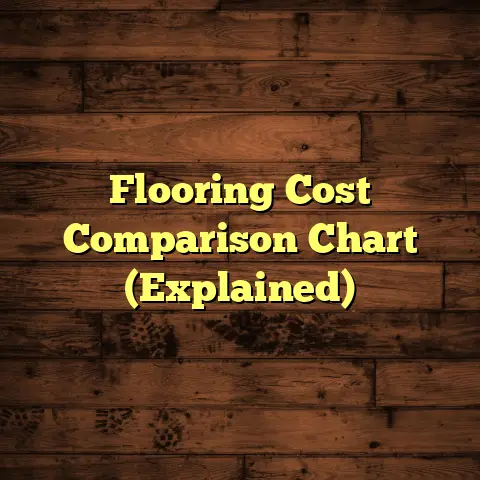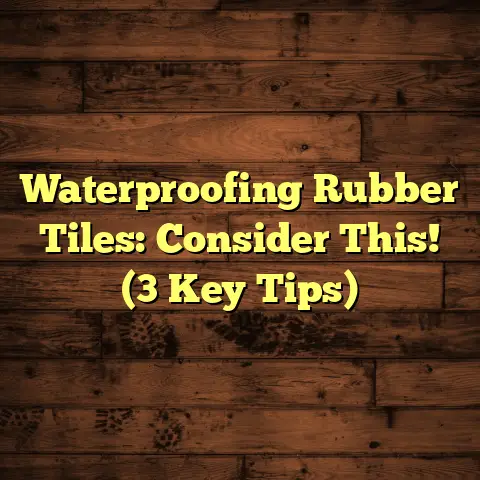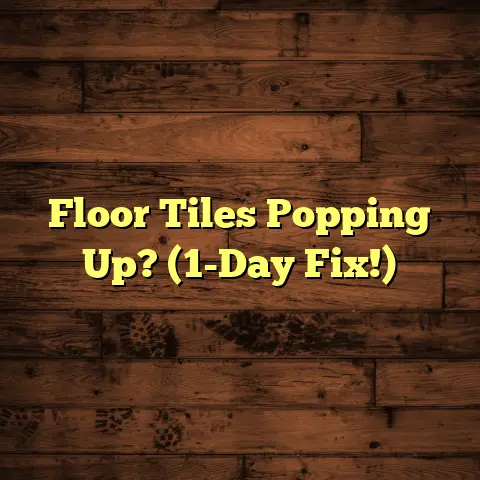Babies Crawl On Hardwood? (3 Safety Tips!)
(3 Safety Tips!)
Did you know that over 60% of homes in the
U.S.
boast beautiful hardwood floors?
They’re stunning, durable, and relatively easy
to clean (a HUGE win with little ones!).
But here’s the kicker: many parents are
unaware of the potential risks those gleaming
planks pose to their precious, crawling
bundles of joy.
Shocking, right?
So, let’s get down to brass tacks.
I’m going to share three essential safety tips
to help you create a safe and happy crawling
environment for your little explorer.
The Allure of Hardwood:
Why We Love It
Let’s be honest, hardwood floors are gorgeous.
They add a touch of elegance and warmth to any
home.
I’ve seen countless homeowners swoon
over the rich tones and natural grain patterns
of oak, maple, and walnut.
But it’s not just about looks, is it?
Hardwood is known for its durability.
A well-maintained hardwood floor can last for
decades, withstanding the daily wear and tear
of family life.
And, let’s face it, with kids
around, “wear and tear” is an understatement!
And then there’s the cleaning aspect.
Compared to carpets, hardwood is a breeze to
clean.
Spills, crumbs, and those inevitable
“accidents” can be quickly wiped away, keeping
your home looking fresh and hygienic.
So, it’s no wonder why so many families,
including those with babies, opt for hardwood.
It’s a practical and stylish choice that seems
to tick all the boxes.
But…
Understanding the Risks:
It’s Not All Sunshine and Crawls
Now, before you start picturing your little
one happily cruising across those beautiful
planks, let’s talk about the potential
downside.
Hardwood, while lovely, presents a
few challenges for crawling babies.
- Slippery Surfaces:
This is the big one.
Hardwood can be incredibly slippery, especially for a baby who’s still mastering the art of crawling.
Those tiny hands and knees can easily lose their grip, leading to tumbles and falls. - Hardness Factor:
Ouch!
Hardwood is, well, hard.
A fall on hardwood can result in bumps, bruises, and even more serious injuries.
Think about it – babies have delicate little heads and bodies, and hardwood offers zero cushioning. - Temperature Troubles:
Ever walked barefoot on a cold hardwood floor
in the winter?
Not a pleasant experience, right?
Hardwood can get surprisingly cold, which can be uncomfortable for a baby spending a lot of time on the floor.
Conversely, it can also get quite warm during the summer months, potentially leading to overheating.
According to the CDC, falls are a leading cause
of non-fatal injuries for children under one year
old.
While not all falls happen on hardwood, it’s
important to acknowledge that this surface can
increase the risk.
I’ve seen firsthand the consequences of these
risks.
I remember one family who called me in a
panic after their baby had taken a nasty tumble
on their newly installed hardwood floor.
Thankfully, the baby was okay, but it was a
wake-up call for them – and for me.
Okay, enough doom and gloom!
Let’s move on to
the good stuff: how to make your hardwood floors
safe for your crawling baby.
Safety Tips for Parents:
Turning Your Home into a Crawling Paradise
Alright, here’s where we get practical.
I’m going to share three tried-and-true safety
tips that I’ve recommended to countless
families over the years.
These tips are simple,
effective, and will give you peace of mind as
your baby explores their world.
Tip 1: Use Soft Play Mats or Area Rugs
Cushioning is Key
Think of soft play mats and area rugs as your
baby’s personal safety net.
They provide a
cushioned surface that absorbs impact and
reduces the risk of injury from falls.
- Material Matters:
When choosing play mats or rugs, opt for
materials that are non-toxic, easy to clean,
and specifically designed for infants.
Look for labels like “BPA-free” and “phthalate-free.” Foam tiles are a popular choice, but make sure they’re thick enough to provide adequate cushioning. - Placement is Paramount:
Strategically position your play mats or rugs in
the areas where your baby spends the most time
crawling and playing.
High-traffic zones like the living room or playroom are ideal.
Make sure the mats or rugs are securely anchored to the floor to prevent them from slipping or bunching up.
I’ve seen rugs become more of a hazard than help when they slide around! - Easy to Clean:
Trust me, you’ll want something that’s easy to
wipe down or throw in the washing machine.
Spills and messes are inevitable, so choose a material that can handle the chaos.
I always recommend that parents invest in high-
quality play mats or rugs.
It’s a small price
to pay for your baby’s safety and comfort.
Tip 2: Maintain a Safe Play Environment
Hazard-Proofing 101
Creating a safe play environment goes beyond just
adding cushioning.
It’s about eliminating
potential hazards that could cause injury.
- Sharp Object Removal:
This seems obvious, but it’s worth repeating.
Get down on your hands and knees and scan the area for any sharp objects that could pose a risk.
Think staples, paperclips, small toys, or anything else that could be easily swallowed or cause a cut. - Furniture Securing:
Wobbly furniture is a disaster waiting to
happen.
Secure bookcases, dressers, and other tall furniture to the wall using anti-tip straps.
Babies are surprisingly strong and curious, and they can easily pull down heavy objects. - Electrical Outlet Protection:
Cover all unused electrical outlets with safety
plugs.
These little devices prevent babies from sticking their fingers or objects into the outlets.
It’s a simple and inexpensive way to prevent a potentially serious electrical shock. - Constant Supervision:
I know, you can’t be everywhere at once.
But when your baby is crawling and exploring, it’s crucial to keep a close eye on them.
Babies are quick, and they can get into trouble in the blink of an eye.
I’ve seen some pretty creative hazard-proofing
solutions over the years.
One family I worked
with used pool noodles to cushion the edges of
their coffee table.
Another family created a
makeshift barrier around their fireplace using
cardboard boxes.
It’s all about thinking outside
the box and finding solutions that work for your
home.
Tip 3: Choose Non-Slip Socks and Crawling Gear
Grip is Your Friend
Even with play mats and a hazard-proofed
environment, it’s still important to give your
baby an extra boost of grip.
That’s where non-
slip socks and crawling gear come in.
- Non-Slip Socks:
Look for socks with rubberized grips on the
soles.
These grips provide traction on hardwood floors, preventing slips and falls.
Make sure the socks fit snugly and don’t slide down. - Crawling Gear:
There are a variety of crawling gear options
available, including knee pads, elbow pads, and
even full-body crawling suits.
These items provide extra cushioning and protection for your baby’s joints. - Proper Fit:
When choosing crawling gear, make sure it fits
properly and doesn’t restrict your baby’s
movement.
You want them to be able to crawl freely and comfortably.
I’ve noticed a huge difference in babies’
confidence and mobility when they’re wearing
non-slip socks or crawling gear.
It gives them
the extra grip they need to explore without fear
of falling.
Real-Life Experiences:
Lessons from the Trenches
I’ve talked a lot about theory, but let’s get
real for a minute.
What do other parents say
about babies crawling on hardwood?
I recently spoke with a mom named Sarah, who
shared her experience with me.
“We have hardwood
floors throughout our entire house,” she said.
“When my son started crawling, I was terrified
he was going to hurt himself.
We invested in
some thick play mats and non-slip socks, and it
made a world of difference.
He’s much more
confident and doesn’t fall as much.”
Another parent, David, told me that he used
pool noodles to cushion the edges of his
furniture.
“It’s not the most stylish solution,”
he admitted, “but it works!
My daughter has
bumped her head a few times, but the pool
noodles have definitely prevented any serious
injuries.”
These stories highlight the importance of being
proactive and taking steps to create a safe
crawling environment.
It’s not about bubble-
wrapping your baby, but about minimizing the
risks and giving them the freedom to explore and
learn.
Conclusion:
Safety First, Always
Alright, we’ve covered a lot of ground. Let’s recap the key takeaways:
- Hardwood floors can be slippery and hard, posing a risk to crawling babies.
- Soft play mats and area rugs provide cushioning and reduce the risk of injury.
- Maintaining a safe play environment by removing hazards is crucial.
- Non-slip socks and crawling gear enhance grip and prevent falls.
By implementing these safety tips, you can transform your hardwood floors from a potential hazard into a safe and stimulating environment for your crawling baby.
Final Thoughts:
Your Home, Your Baby, Your Peace of Mind
As a flooring contractor, I’ve seen it all.
I’ve
seen families struggle with hardwood floors that
are unsafe for their babies.
And I’ve seen
families create beautiful, safe spaces where
their little ones can thrive.
The choice is yours.
Take a good look at your
home, assess the risks, and make the necessary
adjustments to ensure your baby’s safety.
It’s
an investment in their well-being and your own
peace of mind.
Remember, you’ve got this!
You’re doing an
amazing job, and your baby is lucky to have you.
Happy crawling!





